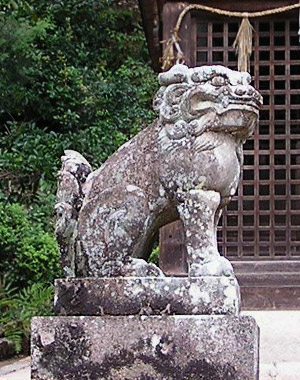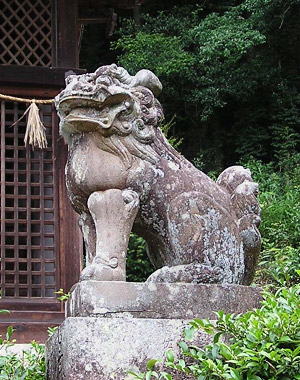|
||
 |
||


Ujigami
Jinja Honden 宇治上神社本殿 (Kyoto)
(C)2001 Japanese Architecture and Art Net Users System. No reproduction or republication without written permission.
掲載のテキスト・写真・イラストなど、全てのコンテンツの無断複製・転載を禁じます。
|
||||||
| komainu 狛犬 | ||||||
| KEY WORD : art history / iconography | ||||||
| Lit. Korean dog. A pair of lion-like guardian figures placed at each side of a shrine or temple entrance; believed to ward off evil spirits. Thought to have been brought to Japan from China via Korea, their name is derived from Koma 高麗, the Japanese term for the Korean kingdom of Koguryo (Jp: Koukuri 高句麗). In the early Heian period, the two statues were clearly distinguished: the figure on the left, called shishi 獅子 (lion), resembled a lion with its mouth open *agyou 阿形; the figure on the right, called komainu 狛犬 (Korean dog), resembled a dog with its mouth closed ungyou 吽形, and sometimes had a horn on its head. Gradually the term komainu came to be used for both statues, and their shapes became indistinguishable except for the open and closed mouths *a-un 阿吽. In the Heian period komainu were used as weights or door-stops for curtains and screens in the Seiryouden 清涼殿, Kyoto Gosho 京都御所. Other famous examples include a pair of painted wooden komainu (10-11c) at Yakushiji 薬師寺, Nara; 14 painted and lacquered wooden figures at Itsukushima Jinja 厳島神社 (12-14c) Hiroshima prefecture, and the stone figures inside the south gate of Toudaiji 東大寺, Nara, made by the 12c Chinese sculptor Chinnakei 陳和卿. | ||||||

 Ujigami
Jinja Honden 宇治上神社本殿 (Kyoto)
|
||||||
| REFERENCES: | ||||||
| EXTERNAL LINKS: | ||||||
| NOTES: | ||||||
(C)2001 Japanese Architecture and Art Net Users System. No reproduction or republication without written permission. 掲載のテキスト・写真・イラストなど、全てのコンテンツの無断複製・転載を禁じます。 |
||||||